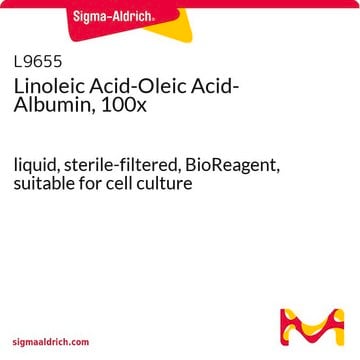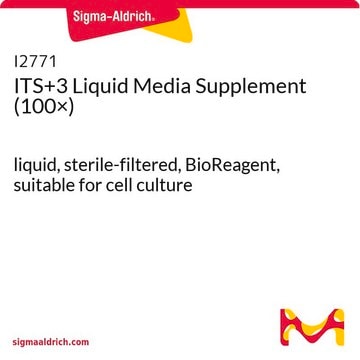L9530
Linoleic Acid-Albumin from bovine serum albumin
liquid, sterile-filtered, BioReagent, suitable for cell culture
Synonim(y):
Linoleic Acid-Albumin from BSA
About This Item
Polecane produkty
opis
Contains 2 moles linoleic acid per mole BSA
sterylność
sterile-filtered
linia produktu
BioReagent
Postać
liquid
stężenie
100 mg/mL BSA in DPBS
90-120 mg/mL protein (biuret)
metody
cell culture | mammalian: suitable
zanieczyszczenia
≤400 EU/mL endotoxin
temp. przechowywania
2-8°C
Powiązane kategorie
Opis ogólny
Zastosowanie
Inne uwagi
Kod klasy składowania
10 - Combustible liquids
Klasa zagrożenia wodnego (WGK)
WGK 3
Temperatura zapłonu (°F)
Not applicable
Temperatura zapłonu (°C)
Not applicable
Środki ochrony indywidualnej
Eyeshields, Gloves
Certyfikaty analizy (CoA)
Poszukaj Certyfikaty analizy (CoA), wpisując numer partii/serii produktów. Numery serii i partii można znaleźć na etykiecie produktu po słowach „seria” lub „partia”.
Masz już ten produkt?
Dokumenty związane z niedawno zakupionymi produktami zostały zamieszczone w Bibliotece dokumentów.
Klienci oglądali również te produkty
Produkty
Importance and uses of linoleic acid in serum-free eukaryotic, including hybridoma and Chinese Hamster Ovary (CHO) cell, cultures
Nasz zespół naukowców ma doświadczenie we wszystkich obszarach badań, w tym w naukach przyrodniczych, materiałoznawstwie, syntezie chemicznej, chromatografii, analityce i wielu innych dziedzinach.
Skontaktuj się z zespołem ds. pomocy technicznej









